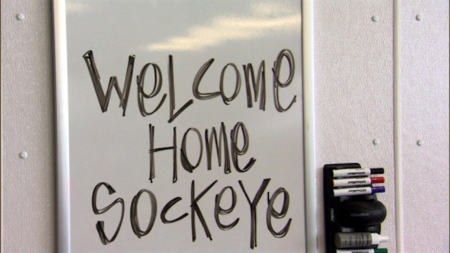Power Shift on the Columbia
After a century of conflict on the Columbia between salmon and dams, the fates of these two iconic energy systems are now intertwined.
Fewer than two dozen critically endangered sockeye salmon returned to Idaho’s upper Salmon River valley on the edge of the Sawtooth Mountains in the summer of 2019. Nine hundred miles from the ocean, exhausted and battered and just short of their life’s fruition, these salmon are netted from the creek below Redfish Lake, trucked 140 miles to a cavernous warehouse in the desert outside Boise, anesthetized in a cooler, stunned by mallet blows to the head, milked for milt and stripped of eggs for mixing in a Ziploc bag. With the swirl of a fisheries biologist’s wrist, the next generation begins life in a redd of plastic tanks, aerators and PVC piping. In black marker, a whiteboard sign on the wall calls out from the ersatz world: “Welcome Home, Sockeye”
Home?
Twenty-seven years ago, I began working as a river guide along the elevated vasculature of the Snake and Columbia River systems, an alpine womb for one of the most productive salmon fisheries on the planet. I was young, well-insulated from the burdens of conflicting education or experience, and I eagerly adopted and narrated the storied iconography of wild creatures in wild places. I read the books and heard the accounts of what it used to be, when the kings of the sea would return to their mountainous throne. But the relative richness of that past was an anecdote—black-and-white pictures and someone else’s fuzzy memories.
It took me a while to see my experience of guiding, facilitating what is now essentially a leisure pursuit, as a gentrified remnant of the relationship communities like Salmon, Idaho, had with their eponymous river when it was full of fish. Once I got it, I got involved. On the river and off, I advocated, lobbied, rallied for restoration—of the biological integrity of watersheds and the resource-based economies of rural Idaho. But public engagement was proxy for a kind of personal search, an attempt to resolve the paradox that much of the Pacific Northwest now lives within: strong identification with the idea of a natural and cultural heritage derived from abundant salmon, but having just missed out on the heritage itself.
My generation inherited a different energy system. Over 300 dams impound the Columbia and its tributaries—perhaps the most hydroelectrically engineered river system on Earth. Water flows freely for a little over 50 miles of the nontidal Columbia’s 745-mile length in the United States. Only two of its major tributaries, the John Day River in Oregon and the Salmon River in Idaho, remain undammed. Along the mainstems of the Columbia and Snake, the river has been almost completely abstracted; water released downstream for purposes other than mechanical work is referred to as “spill,” suggesting such events are both unfortunate and temporary.

Juvenile Steelhead and Chinook at a juvenile collection facility, where they will soon be loaded on a barge or truck for transportation downriver. STEVE PETTIT.
And instead of wild salmon and the riot of life they nourished, we inherited a vast network of concentrated animal feeding operations. Over 170 state and federal hatchery programs mass-produce an average of 150 million juvenile salmon for release into the Columbia and its tributaries each year. The accompanying suite of increasingly creative and expensive alternatives to salmon simply swimming up and downstream includes climate-controlled rearing tanks, surgically implanted tracking devices, transportation in trucks and barges to the ocean, and the harassment or killing of natural predators. Returning adults are harvested in hatchery labs, their pasteurized and frozen remains scattered in forests and streams starved for missing nutrients.
We have turned the river and its salmon into avatars of themselves.

Hatchery theory is to have precise control over all variables. Salmon theory is to diversify in their adaptations to the particular conditions of their home water. Here, juvenile salmon incubate in their unnaturally regulated trays at a hatchery in Washington. JIM NORTON.

Our techno-industrial approach to producing salmon has left them more vulnerable than ever to changing conditions in their environment. Here an entire batch of hatchery juveniles, wiped out by a virus, wait to be disposed. STEVE PETTIT.
This approach is as ineffective as it is audacious. While captive broodstock programs have extended lifelines to extirpated populations, the techno-industrial mitigation complex is an unambiguous failure as a strategy for “saving” Columbia River salmon. One of the most expensive ecological recovery programs in US history has never worked, and nearly every group of independent fisheries biologists has told us it never will. Wild salmon numbers have declined over 95 percent, not a single endangered or threatened salmon run has been recovered despite more than $16 billion spent on the enterprise, and a growing portfolio of research enumerates the deleterious effects of hatchery fish on wild populations.
Linear mass production, it turns out, is not a surrogate for regenerative fecundity. The heritage of that miscalculation is expressed from starving orcas on the continental shelf to struggling Idaho communities on the continental divide. Removing salmon from the river has ensured the collapse of both.
The extraordinary complexity and expense required to engineer persistent scarcity from self-sustaining abundance is absurd, especially as a framework for conservation. But the federal hatchery-based management program is less a reflection of what science tells us about salmon than a convenient fiction designed to avoid effective recovery action and its inherent challenge to incumbent power structures. It only aspires to narrowly escape thresholds of endangerment within the existing construct, paradoxically leveraging the stubborn survival of salmon to protect the mitigation paradigm from the more intensive and urgent critique it deserves.
In an intriguing twist of fate, the staggering cost of this charade has potentially significant economic implications for Columbia basin hydropower and the agency charged with its marketing. Amidst dramatic changes in western energy markets, the very framework that has entrapped salmon might end up being a key to their partial liberation.
Bonneville Power Administration (BPA), a division of the Department of Energy, markets power from 31 federal dams as well as one nonfederal nuclear plant, collectively referred to as the Federal Columbia River Power System (FCRPS). BPA was a New Deal response to the challenges of rural electrification in the mid-1930s, when about one-third of Pacific Northwest farmers connected to the grid. The dams are operated in partnership with the US Army Corps of Engineers and the Bureau of Reclamation, and BPA’s mandate includes covering its costs through electricity sales and related services to about 140 Public Utility District, municipal and other customers under long-term contracts.
For over 80 years, BPA has loomed over the Pacific Northwest’s energy and ecology, providing about 25 percent of the region’s generated electric power, operating 75 percent of our high-voltage transmission lines and directing regional fish and wildlife programs—a sprawling mitigation economy worth over $500 million a year. As reporter Jeremy P. Jacobs astutely describes in a recent series published by Greenwire, “BPA isn’t an agency. It’s an empire”.
Throughout BPA’s history, stakeholders have challenged specific rate-setting policies or species recovery plans. But BPA has purchased lots of favor in the region and remains largely unaccountable in practice—a bizarre mashup of government bureaucracy and corporate monopoly. There has never been a sustained reconsideration of Bonneville’s role in delivering a future of abundance—restored fisheries, a clean and resilient electrical grid and distributed economic opportunities.
That conversation is happening now.
The FCRPS produces about twice as much power as BPA customers have committed to purchase under the agency’s 20-year contracts. Historically, BPA generated substantial revenue selling this surplus into wholesale markets, particularly California. Recently, however, a combination of cheap natural gas and rapidly proliferating renewables reduced both overall demand for Columbia River hydropower and its profitability—“a bloodbath,” as described by BPA’s administrator, Elliot Mainzer.
As a result, from 2008-2017, BPA burned about $900 million of cash reserves in its power business line even while raising rates 30 percent and growing total debt to almost $16 billion. Several BPA customers have indicated they might look to diversify power resources when contracts expire and warned of a “stampede to the exit.”
Amidst this uncertainty, Mainzer repeatedly promotes the agency’s five-year strategic plan to improve its “competitive position,” in part by searching further afield for new markets. While BPA has broad authority to act like a business, it is the federal government. And many Pacific Northwest residents think BPA has implicit and explicit priority obligations to our region, which shouldn’t be a sacrifice zone so an unappropriated federal agency dependent on sales of electricity from a portfolio of aging centralized generators can fight to “remain the power provider of choice,” as Mainzer states. Instead of competing with renewables and using the false promise of hatcheries to protect even the most expensive and ecologically destructive dams, we could aggressively integrate the distributed energy future, creating opportunities to reconnect rivers and restore fisheries.
To do this, we’ll have to draw on an underutilized source of renewable power: our own.
Last April, with a powerful speech in Boise, Idaho Congressman Mike Simpson called for a re-write of the Northwest Power Act, the 40-year old instructions governing the relationship between BPA, the Federal Columbia River Power System, and fish and wildlife programs. And more recently, Oregon Governor Kate Brown has written a letter in support of energy restructuring as a pre-requisite to lower Snake River dam removal. It is imperative that the region join this important conversation. After a century of conflict on the Columbia between salmon and electricity, the fates of these two iconic energy systems are now intertwined—transitioning their production from centralized to distributed, bureaucratic to creative, homogenous to diverse and placeless to place-based will catalyze the largest river restoration in US history, ensure a clean and modern grid and reclaim our missing heritage in a more hopeful future.
We care about Idaho's fish!
Tell Idaho Governor Brad Little and Congressman Mike Simpson they need to help restore healthy salmon runs back to Idaho.

